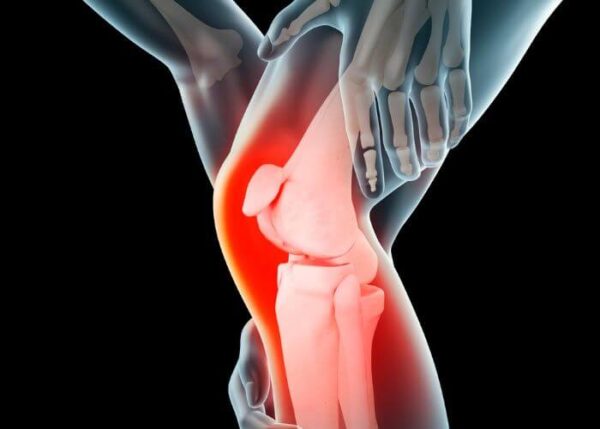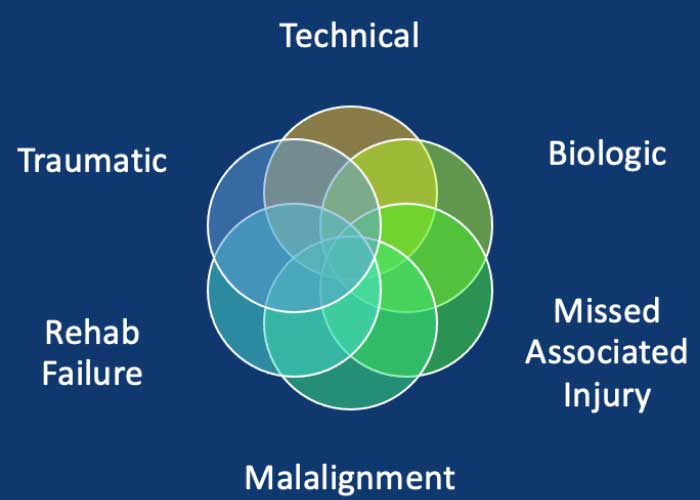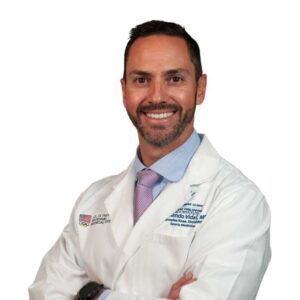So you had an ACL reconstruction and it didn’t turn out as you expected…. What do you do now?
Defining ACL Failure:
Often times ACL failure is defined as the ligament tearing again. Although this clearly is an example of failure, there are many other ways that your surgery may not have been successful.
Dr. Vidal and his colleagues at the Steadman Clinic in Vail understand that the goal of ACL surgery is a stable, pain-free, functional knee that allows an athlete to return to all fitness and sporting activities without restriction or limitation.
Looking at it through this lens failure can be defined as:
- Graft retear / Instability
- Stiffness (loss of motion)
- Pain / swelling
- Lack of function / inability to return to sport/activity
Defining the dysfunction and clearly defining an athlete’s expectations are the key to a successful outcome. Dr. Vidal is highly experienced in ACL surgery and ACL revision surgery for patients in the Vail, Aspen and Denver metro areas.
To learn more about ACL failure and Dr. Vidal’s role in redefining what a torn ACL means for professional athletes, please read: Dinwiddie out to prove doubters wrong

What is a Revision ACL Reconstruction?
The anterior cruciate ligament (ACL) is the most commonly torn ligament in the knee. This injury is most often seen in the athletic population due to quick starts, stops, jumping, knee rotation and/or a blow to the knee. The ACL does not usually heal on its own and if an injury does occur, many athletes undergo ACL reconstruction surgery to return the full function and stability to the knee.
Although ACL reconstruction has a high success rate, some patients have poor results, or re-injure the ligament. As many at 10 percent of the patients who have ACL reconstruction, experience a failure of the reconstructed ligament to heal properly, or a re-tear. Complex knee surgeon, Dr. Armando Vidal, serving patients in Vail, Aspen and the surrounding Denver, Colorado communities is highly skilled at performing revision ACL reconstruction and returning patients to their active lifestyle.
What factors contribute to failure of ACL Reconstruction Surgery?
- Technical: Placement of the tunnels for ACL surgery is the key to a successful reconstruction. Malposition of tunnels can lead to graft failure, instability or loss of motion. This is one of the most common causes of ACL graft failure.
- Associated Ligament Injury: ACL injury often occurs in the context of other pathology such as meniscal tears or collateral ligament injury. Many of these can be identified and treated at the time of surgery. In fact, many of these can heal on their own without much intervention. However, some are clinically significant and require surgery. Persistent instability in one ligament can put additional strain on the ACL graft and result in failure.
- Biologic: Appropriate graft choice is an important decision in ACL surgery. Allografts (from a cadaver) have a 3x higher failure rate in kids and adolescents when compared to autografts (one’s own body tissue).

- Rehab: Postoperative rehab and a clear, well defined return to play progression and protocol is key to success. ACL surgery is a team sport. All members of the team (surgeon, therapist and patient) must work in concert to achieve a good outcome
- Alignment: There is increasing awareness that bony alignment is associated with ACL injury and specifically ACL tear. Failure to evaluate alignment and tibial slope can result in failure of a revision reconstruction.
- Meniscal Status: The menisci and meniscal roots have an important role in stability of the ACL reconstructed knee. It is common for a failed ACL to have had previous meniscal surgery and meniscal deficiency or root dysfunction can coexist in this setting.
- Trauma: This is a diagnosis of exclusion. If you can tear the ACL that you were born with, you can clearly tear the ACL that we reconstruct.
How do I know if my ACL reconstruction failed?
There are several reasons an ACL reconstruction may have failed. Some patients may have returned to sports too soon or did not take enough time to rehabilitate the injury. Some patients experience new trauma such as a fall, or new sports injury. Other patients may have a graft failure from a previous surgery. Symptoms of a failed ALC reconstruction include:
- Knee instability
- Pain with daily activities
- Stiffness and loss of range of motion
- Recurrent swelling
- Inability to return to sports activities.
When should I have a revision ACL reconstruction?
Revision ACL reconstruction is a more difficult surgery to perform than an ACL reconstruction. Patients in Vail, Aspen and surrounding Denver, Colorado communities should consult with Dr. Armando Vidal, who has had extensive experience with successful revision ACL reconstruction. Dr. Vidal will take the time to answer all of a patient’s questions and advise them of the best route to take for proper healing. Many of Dr. Vidal’s patients have excellent results and return to a high level of activity without further knee instability.
How is revision ACL reconstruction done?
The first step is to identify the reasons why the ACL reconstruction failed in the first place. These issues must be addressed for a successful ACL revision. At a minimum, Dr. Vidal performs the surgery much like the primary ACL surgery, where an allograft or autograft is used to reconstruct the damaged ligament.
However, ACL revisions often require more work than primary reconstructions. This can include osteotomies to change alignment, meniscal repairs/transplants or other ligament reconstructions.
For several patients the previous graft or hardware is malpositioned, or the previous tunnels have undergone dilation (bigger than when they were initially placed) and the ACL revision needs to be performed in two stages as a result. The first stage involves a bone graft to fill damaged areas with new bone, followed by a revision ACL reconstruction three months later. The two separate surgeries allow for maximum healing of the knee joint and optimal placement of the graft.
What is the recovery like after revision ACL reconstruction?
Every revision ACL reconstruction is different and as a result, recoveries can vary quite a bit depending on what needs to be done. If it is a simple revision ACLR (one stage without need for complex reconstructions or osteotomies) patients who have already experienced an ACL reconstruction will find a similar procedure for revision ACL reconstruction. After surgery, patients will start therapy almost immediately and their protocol will be determined by Dr. Vidal and the physical therapist depending on the extent of the reconstruction and associated procedures.
Dr. Vidal strongly recommends a thorough rehabilitation program to be followed in order for his patients to regain the full strength and mobility of their knee. It is not unusual for patients to use a functional brace once they have returned to their sporting activities, especially for the first two years following revision surgery.
ACL Restoration Surgeon
Did you receive surgical treatment for a previously torn ACL and are now experiencing new difficulties? If so, you may have experienced a failed ACL reconstruction. ACL reconstructions can fail for a number of reasons, but it is extremely important to seek treatment if instability or pain has returned after ACL surgery. Complex knee surgeon, Doctor Armando Vidal provides diagnosis as well as surgical revision for patients in Vail, Aspen, and the surrounding Denver, Colorado communities who have experienced a failed ACL reconstruction. Contact Dr. Vidal’s team today!

Locations
180 S Frontage Rd W
Vail, CO 81657
226 Lusher Court
Ste 101
Frisco, CO 80443
322 Beard Creek Road
Edwards, CO 81632


